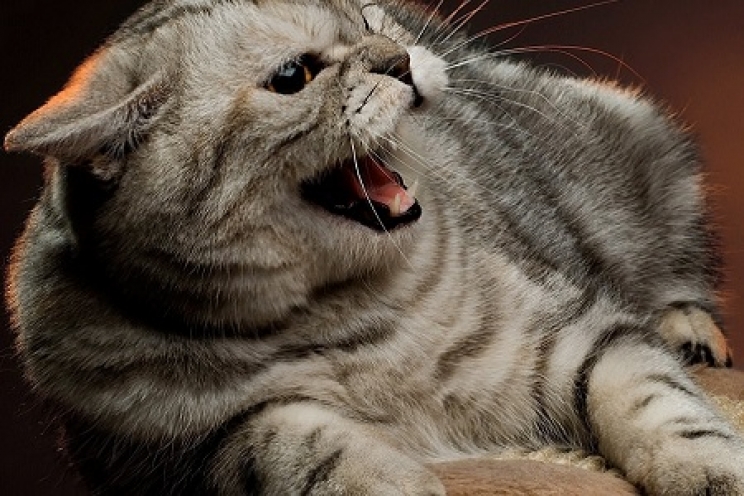Aggressiveness in cats is very common. However, we might come across an untamable animal, which will attack both us, and animals surrounding it. Therefore, what is the reason to this behavior? What can we do to solve this problem?
Why does our cat attack?
Cats are known to be predators and territorial animals. This means that, Mother Nature gave them this impulse to act aggressively when someone invades their privacy or personal space.
Dogs, on the other hand, only show their perfect teeth to the enemy. Cats are able to use both their teeth and their sharp claws to attack.
Animals do not usually appeal to aggressive manners just because they want to, they will become aggressive only in certain uncomfortable circumstances for them such as threats or fear. Aggressiveness will be anticipated by other behaviors your animals will have towards other people and other animals.
Generally, the aggression has three different phases: threat, the real physical aggression and the end of the fight.
The threat phase is the phase where the animal will try to install fear in the enemy to show they are in control. The cat might puff, growl, flap its tail, arch their back and lower on their legs. By doing this, the cat is warning the other animal to back off immediately before the situation becomes violent.
The aggression is usually sustained by some scratches and bites, which might seem insignificant for their dimensions but can really cause some great damage and pain. Usually, scratches with finger nails are usually pointed towards the eyes of the enemy. This is one of the reason why cats tend to always win fights with dogs.
The end of the fight is marked by the surrender of one of the two opponents. They just run away.
Types of aggressiveness
An aggressive cat usually has some reason. These might be one of them:
- Irritation aggressiveness: even a seemingly calm cat can react aggressively with various provocations from children or other animals. The same thing can happen if we try to trim their fingernails (they refuse to proceed if they find the situation too irritating). The main reasons that encourages a cat to react in this way might be physical pain, frustration or forcing them to do something they do not want to. Not all of these factors are healthy for our animal as they increase the stress levels exponentially. This type of aggressively is usually linked to animals that are not used to human contact;
- Fearful aggression: when a cat is scared, it can react either attacking or running away from the danger. If we try to pet or grab out cat in these situations the result will usually be bites and scratches. The best thing we can do is leave him alone to reduce the fear they have in that moment. The main reason they attack in this case is also severe stress from the situation.
- Territorial aggression: cats are usually solitary animals. Rather, felines tend to associate in colonies, with respect for their spaces and for their independence. For this reason, if a cat does not accept a new animal or if another cat invades its personal space, it will most definitely react by attacking;
- Redirected aggression: this is a very particular form of aggression, typical of felines. The typical example is represented by the cat’s intent on pointing his favorite mouse-toy, and when we caress him, he scratches us. In this case, he did nothing but redirect the aggressiveness he would have liked to pour on the mouse, on our hand. Another example can be represented by the cat who sees a prey outside the window, and, being unable to catch it, directs his frustration towards the first thing or person that is nearby him;
- Physical contact aggression: not all cats love touched or petted. As a rule, in fact, they are the ones who decide when to start cuddles and when to stop them. For the luckiest owners, cats can show that they had enough by simply walking away. It can happen, however, that some cats attack because they no longer want to be touched. In this case, it may be stress or dominance prevailing on them. However, the mechanism underlying aggression from physical contact is not yet fully understood;
- Physical pain aggression: when cats are feeling sick, they do not like to be touched at all. For this reason, they will tend to attack anyone who approaches them to pet them or pick them up. In these cases, you must contact your vet to understand the origin of your cat's problem.


What do I do?
Some people think that by punishing or blaming the animal, it will stop immediately. However, it is useless to do so.
Aggression is in fact correlated to emotions such as fear, anxiety, stress or frustration. Shouting or waving your hands aggressively in front of them will increase these emotions and will provoke the opposite effect.
It is best to act passive and not react immediately to a bite or a scratch from a pet to further understand the causes of such behavior.
If we think about it, maybe we have been the main cause that lead them to attack us. By going close to them or forcing them to come close to us which might frighten the cat.
Too often owners ask their animals for excessive effort to tolerate certain situations. A dog that cannot stand coats and walking bags will react with a huge sense of frustration, which can sometimes lead to aggression. In the same way, a cat will hardly let himself be "humanized" with hats and rompers, however nice they may seem to the owner.
If after all of these things, we receive a bite or a scratch we can’t blame our pet that much!
An excellent advice can certainly be to prevent aggression by observing the cat's verbal and physical language. When a feline puffs, growls, arches its back, puffs its fur and flaps its tail, it is clearly telling us not to get close.
So, let us listen to what our cat has to tell us, without saying that he had not warned us.
Forewarned is forearmed.











